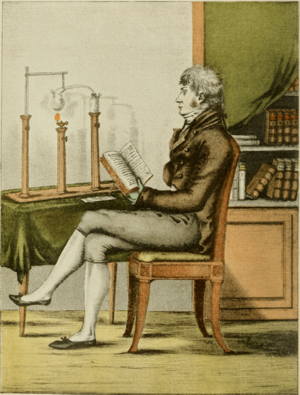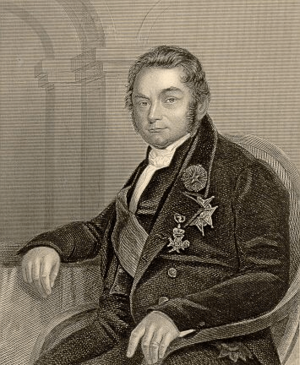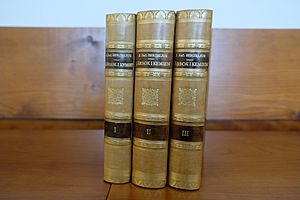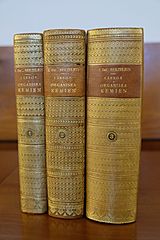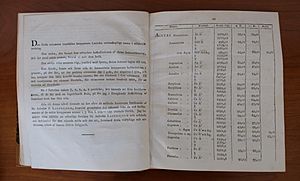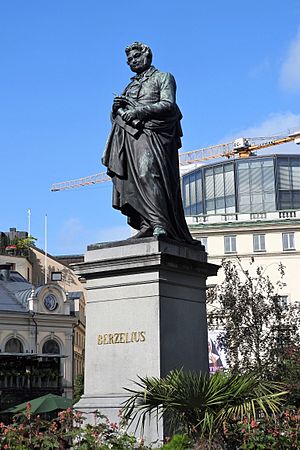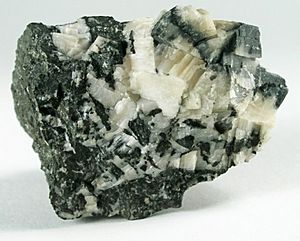Jöns Jacob Berzelius facts for kids
Quick facts for kids
Jöns Jacob Berzelius
|
|
|---|---|
 |
|
| Born | 20 August 1779 Väversunda, Östergötland, Sweden
|
| Died | 7 August 1848 (aged 68) Stockholm, Sweden
|
| Nationality | Swedish |
| Alma mater | Uppsala University |
| Known for | Atomic weights Chemical notation catalysis Silicon Selenium Thorium Cerium |
| Awards | Copley medal (1836) |
| Scientific career | |
| Fields | Chemistry |
| Institutions | Karolinska Institute |
| Doctoral advisor | Johann Afzelius |
| Doctoral students | James Finlay Weir Johnston Heinrich Rose Friedrich Wöhler |
| Member of the Swedish Academy (Seat No. 5) |
|
| In office 20 December 1837 – 7 August 1848 |
|
| Preceded by | Carl von Rosenstein |
| Succeeded by | Johan Erik Rydqvist |
Baron Jöns Jacob Berzelius (20 August 1779 – 7 August 1848) was a famous Swedish chemist. Many people see him as one of the founders of modern chemistry. Other important chemists include Robert Boyle, John Dalton, and Antoine Lavoisier.
Berzelius joined the Royal Swedish Academy of Sciences in 1808. From 1818, he worked as its main leader. In Sweden, he is known as the "Father of Swedish Chemistry." People celebrate Berzelius Day on August 20th to honor him.
Even though Berzelius started as a doctor, his biggest impact was in electrochemistry and stoichiometry. Stoichiometry is about how elements combine in exact amounts. He figured out atomic weights and helped us understand the "Law of Constant Proportions." This law says that elements in a compound always combine in the same fixed ratios.
Berzelius believed that new ideas in chemistry must match what was already known. He made better ways to analyze chemicals. He also studied isomerism, allotropy, and catalysis. He even gave these ideas their names. Berzelius was also one of the first to explain the differences between inorganic compounds and organic compounds. He discovered cerium and selenium. He was also the first to isolate silicon and thorium.
Berzelius showed how an electrochemical cell could break down compounds. This led to his idea of electrochemical dualism. He thought chemical compounds were like salts held together by electric forces. This idea was helpful but later found to be incomplete. His work on atomic weights and this theory helped him create a modern system for chemical formulas. His system used letters for elements and numbers to show how many atoms were present. He used superscripts (like H2O), but later chemists changed them to subscripts (like H2O).
Contents
Biography of Jöns Jacob Berzelius
Early Life and Education
Jöns Jacob Berzelius was born in Väversunda, Sweden. His father was a school teacher, and his mother was a homemaker. Sadly, he lost both parents when he was very young. After his mother died in 1787, relatives in Linköping took care of him.
As a teenager, he worked as a tutor on a farm. During this time, he became very interested in collecting flowers and insects. He enjoyed learning how to classify them.
Berzelius later studied to become a medical student at Uppsala University from 1796 to 1801. There, he learned chemistry from Anders Gustaf Ekeberg. Ekeberg was the person who discovered tantalum. Berzelius also worked in a pharmacy, where he learned practical lab skills like glassblowing. He even successfully repeated experiments by Carl Wilhelm Scheele, which led to the discovery of oxygen.
In 1800, Berzelius learned about Alessandro Volta's electric pile, which was the first battery. He built his own battery using copper and zinc disks. This was the start of his work in electrochemistry. For his medical studies, he researched how electric currents affected diseases. He found no clear evidence for this. Berzelius became a medical doctor in 1802. He worked as a doctor near Stockholm until a chemist named Wilhelm Hisinger saw his talent. Hisinger gave him a laboratory to work in.
Academic Career and Contributions
In 1807, Berzelius became a professor of chemistry and pharmacy at the Karolinska Institute. From 1808 to 1836, he worked with Anna Sundström, who was his assistant. She was the first female chemist in Sweden.
In 1808, he became a member of the Royal Swedish Academy of Sciences. The Academy was not doing well at that time. In 1818, Berzelius became the Academy's secretary. He held this job until 1848. Many people say he helped the Academy become strong again. He was also honored by academies in other countries, like the American Academy of Arts and Sciences.
In 1837, he became a member of the Swedish Academy.
Temperance Movement Involvement
Berzelius was also part of the temperance movement. This movement encouraged people to drink less alcohol. He helped start the Swedish Temperance Society in 1837 and was its first chairman. He even wrote a foreword for a book about temperance.
Later Life and Legacy
Berzelius had many health problems throughout his life, including headaches and gout. He also had times when he felt very sad.
In 1818, he had a nervous breakdown from too much work. Doctors told him to travel and rest. But instead, he went to France to work in other chemical laboratories.
In 1835, when he was 56, he married Elizabeth Poppius. She was 24 years old.
Berzelius died on August 7, 1848, at his home in Stockholm. He is buried in the Solna Cemetery.
Key Achievements in Chemistry
Understanding Definite Proportions
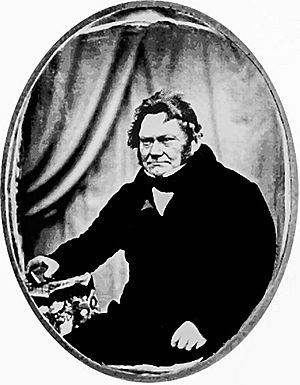
When Berzelius first came to Stockholm, he wrote a chemistry textbook. For this book, he did experiments on how inorganic compounds are made. This was his first work on definite proportions. In 1813, he wrote about how elements combine in compounds. He also introduced his new way of writing chemical symbols.
In 1818, he made a table of relative atomic weights. He set oxygen's weight to 100. This table included all the elements known at that time. His work supported the atomic theory by John Dalton. Dalton's theory said that chemical compounds are made of atoms of different elements. These atoms combine in simple whole number amounts. Berzelius also showed that atomic weights are not always simple multiples of hydrogen's weight. This disproved an earlier idea called Prout's hypothesis.
Inventing Chemical Notation
To help with his experiments, Berzelius created a system for writing chemical formulas. He used simple letters for elements, like O for oxygen or Fe for iron. He used numbers to show how many atoms of each element were in a compound. This system is still used today. The main difference is that Berzelius used superscripts (like H2O), while today we use subscripts (like H2O).
Discovering New Elements
Berzelius is known for discovering the chemical elements cerium and selenium. He was also the first to isolate silicon and thorium. He discovered cerium in 1803 and selenium in 1817. He figured out how to isolate silicon in 1824 and thorium in 1824.
Students who worked in Berzelius's lab also discovered lithium, lanthanum, and vanadium.
Berzelius discovered silicon by repeating an experiment. He reacted silicon tetrafluoride with potassium metal. Then he cleaned the product until it became a brown powder. He recognized this brown powder as the new element, silicon.
He was also the first to isolate zirconium in 1824. However, pure zirconium was not made until 1925.
Creating New Chemical Terms
Berzelius came up with many chemical terms. These include "catalysis", "polymer", "isomer", "protein", and "allotrope." Sometimes, his original definitions were a bit different from how we use them today. For example, he used "polymer" in 1833 for organic compounds that had the same basic formula but different total weights. He thought glucose (C6H12O6) was a polymer of formaldehyde (CH2O). Today, we know that glucose is not a polymer of formaldehyde.
Contributions to Biology and Organic Chemistry
Berzelius was the first to clearly separate organic compounds (those with carbon) from inorganic compounds. He helped other scientists analyze organic compounds like coffee, tea, and various proteins. He even coined the term protein in 1838. He chose this name because proteins are so important for living things. The word comes from Greek, meaning "of the first rank."
In 1808, Berzelius found that lactic acid is in muscle tissue, not just in milk. He also coined the term biliverdin in 1840.
Challenging Vitalism
In 1810, Berzelius believed in an idea called vitalism. This idea suggested that living things worked because of a mysterious "vital force." He thought that organic compounds could only be made by living organisms. But in 1828, Friedrich Wöhler, one of Berzelius's students, accidentally made urea. Urea is an organic compound. He made it by heating ammonium cyanate, which is an inorganic compound. This showed that organic compounds could be made in a lab, not just by living things. This discovery helped to disprove the idea of vitalism.
Works by Berzelius
- (in de) Berzelius und Liebig. München: Lehmann. 1893. https://gutenberg.beic.it/webclient/DeliveryManager?pid=10960569.
- (in en) Letters of Jöns Jakob Berzelius and Christian Friedrich Schönbein. London: Williams & Norgate. 1900. https://gutenberg.beic.it/webclient/DeliveryManager?pid=10972644.
- (in de) Selbstbiographische Aufzeichnungen. Leipzig: Johann Ambrosius Barth. 1903. https://gutenberg.beic.it/webclient/DeliveryManager?pid=3917101.
- Lärbok i kemien (in Swedish). Stockholm, Nordström, 1808-1830.
- Tabell, som utvisar vigten af större delen vid den oorganiska Kemiens studium märkvärdiga enkla och sammansatta kroppars atomer, jemte deras sammansättning, räknad i procent (in Swedish). Stockholm : H.A. Nordström, 1818.
Connections with Other Scientists
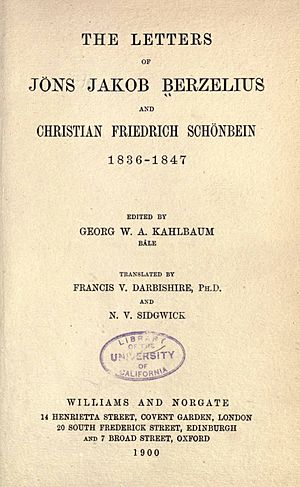
Berzelius wrote many letters to other leading scientists of his time. These included Gerardus Johannes Mulder, Claude Louis Berthollet, Humphry Davy, Friedrich Wöhler, and Eilhard Mitscherlich.
In 1812, Berzelius visited London, England. He met many important British scientists there. These included Humphry Davy, William Hyde Wollaston, Thomas Young, and William Herschel. Berzelius also visited Davy's laboratory. After his visit, Berzelius famously said, "A tidy laboratory is a sign of a lazy chemist."
Humphry Davy suggested in 1810 that chlorine was an element. Berzelius disagreed at first. He believed all acids contained oxygen, and HCl (hydrochloric acid) has no oxygen. However, in 1812, Bernard Courtois proved that iodine was an element. This helped Berzelius accept Davy's idea about chlorine.
Honors and Recognition
In 1818, King Charles XIV John made Berzelius a nobleman. In 1835, he received the title of friherre, which is like a baron.
In 1820, he became a member of the American Philosophical Society.
The Royal Society of London gave Berzelius the Copley Medal in 1836. They honored him for his work on how elements combine in minerals.
In 1840, Berzelius was named Knight of the Order of Leopold. In 1842, he received the honor Pour le Mérite for Sciences and Arts.
A mineral called berzelianite was discovered in 1850. It is a copper selenide and was named after him.
In 1852, Stockholm, Sweden, built a public park and statue to honor Berzelius. Berzeliusskolan, a school next to his old school, is also named after him. In 1890, a street in Gothenburg was named Berzeliigatan (Berzelii street).
In 1898, the Swedish Academy of Sciences opened the Berzelius Museum. It held many items from his laboratory. The museum opened to celebrate 50 years since his death. Scientists from many countries came to honor him. The museum later moved to an observatory.
In 1939, his picture appeared on postage stamps. These stamps celebrated 200 years since the Swedish Academy of Sciences was founded.
The Berzelius secret society at Yale University is also named in his honor.
See also
 In Spanish: Jöns Jacob Berzelius para niños
In Spanish: Jöns Jacob Berzelius para niños


